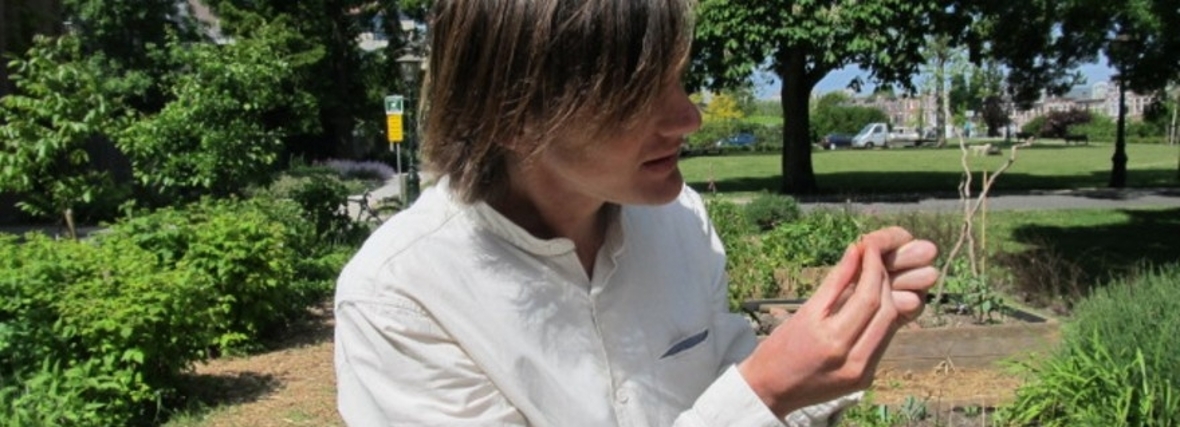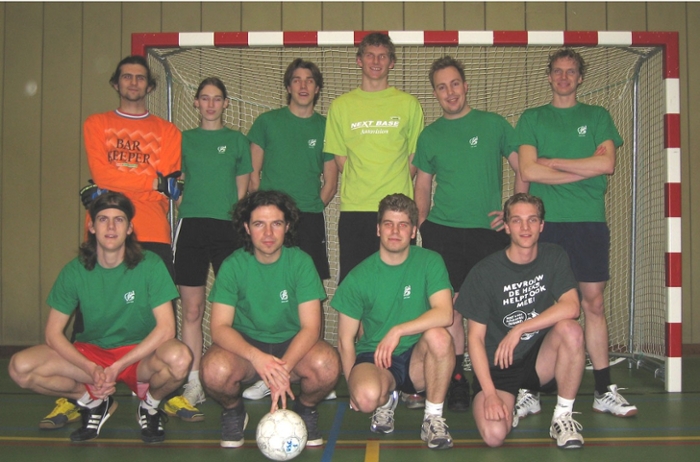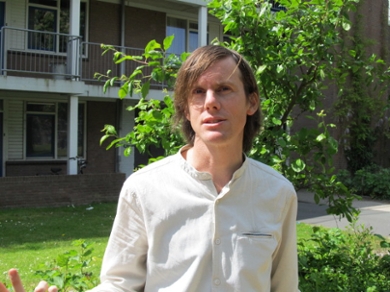
‘Nature likes a mess’
Wouter Moerland is on a two-year secondment as ecology adviser at the Municipality of Leiden. This biology alumnus talks animatedly about his work. ‘We’re working hard to increase nature’s chances in town.’

We’ve only just sat down in the Huigpark in Leiden under a bright May sun but Wouter Moerland is already explaining how he as an ecologist sees the world. The neatly raked Netherlands is not the ideal circumstances for nature, he says: ‘Humans shouldn’t do too much raking and cleaning. Nature is chaos, which makes it unpredictable and surprising.’ After the interview, we wander around and Moerland shows me two square metres of canal bank close to one of the two bridges that eludes the blades of the municipal mower. A whole host of plants have shot up. ‘There’s comfrey growing here! How great is that?’ It’s better not to mention the word ‘weed’ – unless you’re talking about invasive fast-growing exotic plants that are difficult to control such as giant hogweed or Japanese knotweed.
Who? Wouter Moerland (36)
What? Biology, specialisation in Evolution and Ecology (2002-2008)
Association? ‘The Leiden Biologists Club (LBC), not so much for the partying but more for the interesting study excursions like studying moths in the dunes at Wassenaar and sailing through the Nieuwkoopse Plassen to see the unique plants and reed birds there.’
Favourite spot in Leiden? ‘Het Plantsoen. There’s a friendly atmosphere there. But industrial heritage like De Meelfabriek too. Messy cultural history, that’s what I like.’
Personal life? ‘I live in Leiden with my partner and two children.’

What did you do after graduating?
‘While I was at secondary school I already worked as a volunteer at the Natural History Museum in Rotterdam. I was born in Barendrecht and went to school in Rotterdam. I often did voluntary work there during my studies too. When I asked if they had anything for me after I had graduated, they told me I could start immediately. I began as a junior researcher of dragonflies and bats among others. I also studied moths. That’s a real hobby of mine. We’ve got 2,400 species of moths and butterflies in the Netherlands, and 97% of these are moths. They are comparable with butterflies. The caterpillars eat leaves and the butterflies or moths the nectar from flowers. They are enormously diverse. There are even ones without functioning mouthparts. They can’t eat but use themselves as fuel. They reproduce before they use up the fuel and die.
‘The Natural History Museum has a living nature department, Bureau Stadsnatuur (Urban Nature Office), with a team of urban ecologists. They research nature in cities and are commissioned to do so by government, housing associations and developers. The Bureau has seconded me to Leiden as an urban ecologist for two days a week. In this job I get to help make Leiden greener and prettier.’

‘What exactly do you do as an ecologist?
‘An ecologist looks at animals and plants in relation to one another and their environment. It’s very broad. Bureau Stadsnatuur carries out lots of monitoring programmes to see how nature develops locally. In Leiden, you’ve got Stadsnatuurmeetnet, which tracks birds, bats, butterflies, dragonflies and plants. Bureau Stadsnatuur also advises on nature-inclusive building. This means that we help think of measures to introduce that will also give nature a chance. This could mean planting, green roofs and nesting possibilities.’

Do you do that in Leiden too?
‘No, one of the things I’ve been doing in Leiden is to write an advisory report aimed at improving nature across the board. It was about policy but also about specific locations. Of the 31 proposals that I made, 29 have been accepted. Some can be implemented immediately whereas others require more work. To be precise, these relate to giving shape to canal banks and planting that will attract bees, butterflies and birds, but they also relate to mowing lawns and other grass locations. Bees love dandelions, for instance. If you keep on mowing, there’ll be nothing left for the bees. Reducing the number of times that you mow by half would help already.’

‘I started in February 2019 and submitted the report in December. Now I’m helping come up with solutions at a strategic level. I can make good use of the critical and sharp thinking that I learned at the University. Leiden – and this is true for many places in the Netherlands – is trying to separate rainwater from the sewage system. This will involve redeveloping entire streets, which makes it an opportune moment to consider other aspects too: biodiversity; street lighting with regard to moths and bats; parking spaces: wouldn’t it be better to use a half-open substrate for better drainage? And how many frogs and toads end up in road drains and are unable to escape? They starve and die. Surely we can come up with something to prevent this?’

How does an ecologist view climate change?
‘Climate change is well underway and the effects are already visible in nature everywhere. You see, on the one hand, how certain species of plant and animals have become particularly vulnerable and, on the other, how new flora and fauna is advancing. We are increasingly moving towards a Mediterranean climate. In that respect, these are interesting times: nature is changing so much at the moment. We are having more tropical nights, with minimum temperatures above 20°C, and. temperatures above 40°C will regularly engulf us. Then we really will have to do all we can to keep our environment pleasant, for humans and nature. A greener city will help enormously. But not all planting is equally suited to the new conditions, so you have to consider the options well. You have to move to vegetation that can cope better with heat and drought.’
Are there visible effects of the corona crisis in nature?
‘Many things are suspicions or anecdotal. Fewer amphibians may have died while migrating this spring, when they usually cross cycle paths and roads. To what extent urban pigeons, gulls and sparrows – opportunistic animals that live from what humans leave behind – have problems with their food supply… I’m not sure. They are animals that are perfectly adapted to urban life, so they may be well able to switch now there is less human activity. That doesn’t mean that you shouldn’t help sparrows by feeding them though.’
Text: Corine Hendriks
Mail the editorial team
